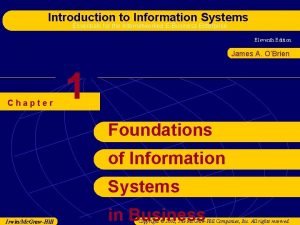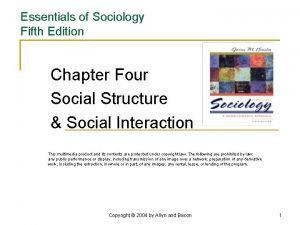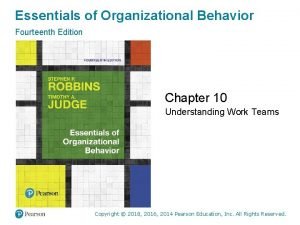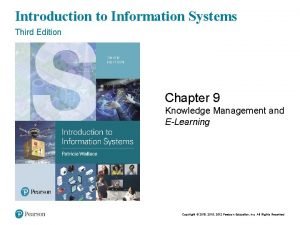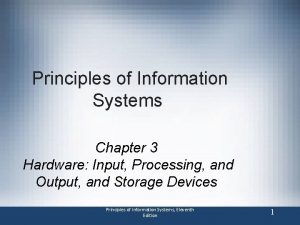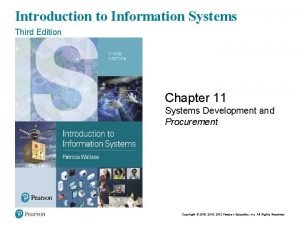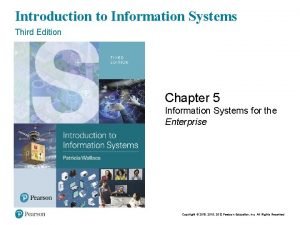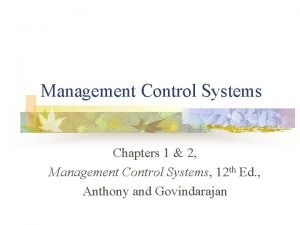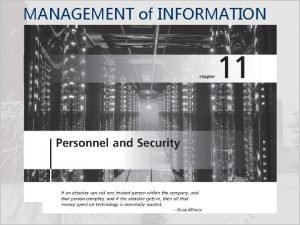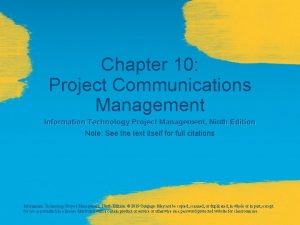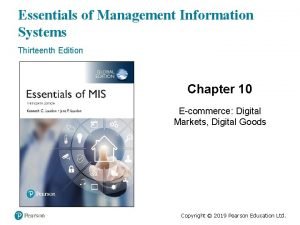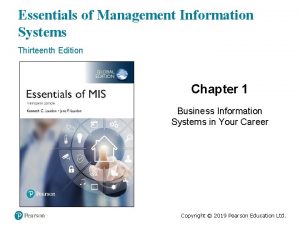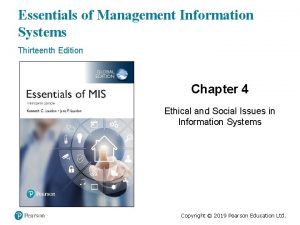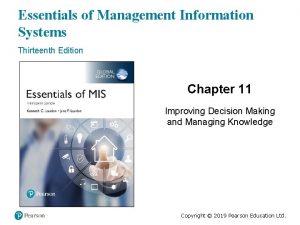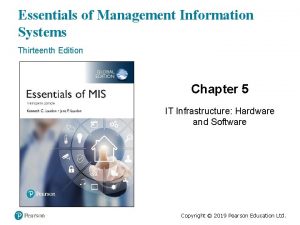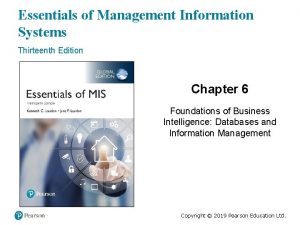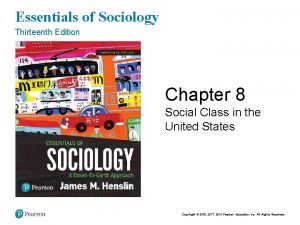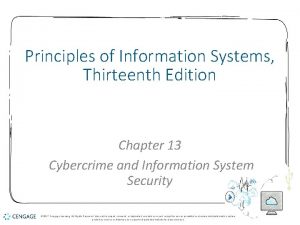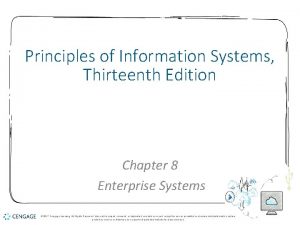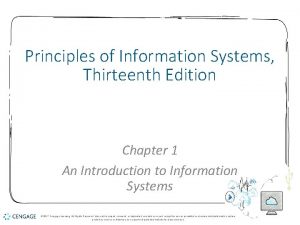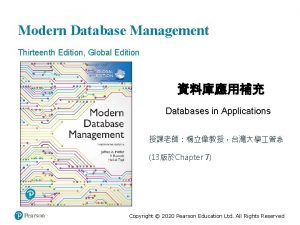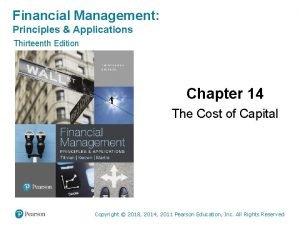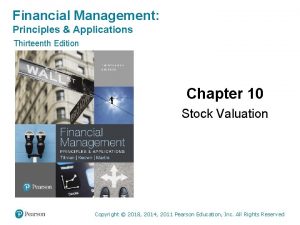Essentials of Management Information Systems Thirteenth Edition Chapter


































- Slides: 34

Essentials of Management Information Systems Thirteenth Edition Chapter 9 Achieving Operational Excellence and Customer Intimacy: Enterprise Applications Copyright © 2019 Pearson Education Ltd.

Learning Objectives 9. 1 How do enterprise systems help businesses achieve operational excellence? 9. 2 How do supply chain management systems coordinate planning, production, and logistics with suppliers? 9. 3 How do customer relationship management systems help firms achieve customer intimacy? 9. 4 What are the challenges that enterprise applications pose, and how are enterprise applications taking advantage of new technologies? 9. 5 How will MIS help my career? Copyright © 2019 Pearson Education Ltd.

Video Cases • Case 1: Life Time Fitness Gets in Shape with Salesforce CRM • Case 2: Evolution Homecare Manages Patients with Microsoft Dynamics CRM • Instructional Video: GSMS Protects Patients by Serializing Every Bottle of Drugs Copyright © 2019 Pearson Education Ltd.

Alimentation Couche-Tard Competes Using Enterprise Systems • Problem – Antiquated IT infrastructure and ERP system – disparate processes for each country and market – massive operational inefficiencies • Solutions – Numerous separate legacy systems replaced with Oracle’s JD Edwards Enterprise. One ERP system • Demonstrates use of technology to maximize supply chain efficiency, integrate data into a common source Copyright © 2019 Pearson Education Ltd.

Enterprise Systems • Enterprise resource planning (ERP) systems • Suite of integrated software modules and a common central database • Collects data from many divisions of firm for use in nearly all of firm’s internal business activities • Information entered in one process is immediately available for other processes Copyright © 2019 Pearson Education Ltd.

Figure 9. 1 How Enterprise Systems Work Copyright © 2019 Pearson Education Ltd.

Enterprise Software • Built around thousands of predefined business processes that reflect best practices – Finance and accounting – Human resources – Manufacturing and production – Sales and marketing • To implement, firms: – Select functions of system they wish to use – Map business processes to software processes ▪ Use software’s configuration tables for customizing Copyright © 2019 Pearson Education Ltd.

Business Value of Enterprise Systems • Increase operational efficiency • Provide firm-wide information to support decision making • Enable rapid responses to customer requests for information or products • Include analytical tools to evaluate overall organizational performance and improve decision-making Copyright © 2019 Pearson Education Ltd.

The Supply Chain • Network of organizations and processes for: – Procuring materials – Transforming materials into products – Distributing the products • Upstream supply chain • Downstream supply chain • Internal supply chain Copyright © 2019 Pearson Education Ltd.

Figure 9. 2 Nike’s Supply Chain Copyright © 2019 Pearson Education Ltd.

Supply Chain Management • Inefficiencies cut into a company’s operating costs – Can waste up to 25 percent of operating expenses • Just-in-time strategy – Components arrive as they are needed – Finished goods shipped after leaving assembly line • Safety stock: buffer for lack of flexibility in supply chain • Bullwhip effect – Information about product demand gets distorted as it passes from one entity to next across supply chain Copyright © 2019 Pearson Education Ltd.

Figure 9. 3 The Bullwhip Effect Copyright © 2019 Pearson Education Ltd.

Supply Chain Management Software • Supply chain planning systems – Model existing supply chain – Enable demand planning – Optimize sourcing, manufacturing plans – Establish inventory levels – Identify transportation modes • Supply chain execution systems – Manage flow of products through distribution centers and warehouses Copyright © 2019 Pearson Education Ltd.

Global Supply Chains and the Internet • Global supply chain issues – Greater geographical distances, time differences – Participants from different countries ▪ Different performance standards ▪ Different legal requirements • Internet helps manage global complexities – Warehouse management – Transportation management – Logistics – Outsourcing Copyright © 2019 Pearson Education Ltd.

Demand-Driven Supply Chains: From Push to Pull Manufacturing and Efficient Customer Response • Push-based model (build-to-stock) – Earlier SCM systems – Schedules based on best guesses of demand • Pull-based model (demand-driven) – Web-based – Customer orders trigger events in supply chain • Internet enables move from sequential supply chains to concurrent supply chains – Complex networks of suppliers can adjust immediately Copyright © 2019 Pearson Education Ltd.

Figure 9. 4 Push- Versus Pull-Based Supply Chain Models Copyright © 2019 Pearson Education Ltd.

Figure 9. 5 The Emerging Internet-Driven Supply Chain Copyright © 2019 Pearson Education Ltd.

Business Value of Supply Chain Management Systems • Match supply to demand • Reduce inventory levels • Improve delivery service • Speed product time to market • Use assets more effectively – Total supply chain costs can be 75 percent of operating budget • Increase sales Copyright © 2019 Pearson Education Ltd.

Interactive Session: Management: Physical Flow in Alibaba • Class discussion – Identify the delivery problems Alibaba faced. How does physical flow impact its business? – What factors contributed to Alibaba’s problems with physical flow? – How did Cainiao Networks impact Alibaba’s business? – How did Cainiao Networks improve the delivery of service for the customer? ‘ Copyright © 2019 Pearson Education Ltd.

Customer Relationship Management • Knowing the customer • In large businesses, too many customers and too many ways customers interact with firm • CRM systems – Capture and integrate customer data from all over the organization – Consolidate and analyze customer data – Distribute customer information to various systems and customer touch points across enterprise – Provide single enterprise view of customers Copyright © 2019 Pearson Education Ltd.

Figure 9. 6 Customer Relationship Management (CRM) Copyright © 2019 Pearson Education Ltd.

Customer Relationship Management Software (1 of 2) • Packages range from niche tools to large-scale enterprise applications • More comprehensive packages have modules for: – Partner relationship management (PRM) ▪ Integrating lead generation, pricing, promotions, order configurations, and availability ▪ Tools to assess partners’ performances – Employee relationship management (ERM) ▪ Setting objectives, employee performance management, performance-based compensation, employee training Copyright © 2019 Pearson Education Ltd.

Customer Relationship Management Software (2 of 2) • CRM packages typically include tools for: – Sales force automation (SFA) ▪ Sales prospect and contact information ▪ Sales quote generation capabilities – Customer service ▪ Assigning and managing customer service requests ▪ Web-based self-service capabilities – Marketing ▪ Capturing prospect and customer data, scheduling and tracking direct-marketing mailings or email ▪ Cross-selling Copyright © 2019 Pearson Education Ltd.

Figure 9. 7 How CRM Systems Support Marketing Responses by Channel for January 2018 Promotional Campaign Copyright © 2019 Pearson Education Ltd.

Figure 9. 8 CRM Software Capabilities Copyright © 2019 Pearson Education Ltd.

Figure 9. 9 Customer Loyalty Management Process Map Copyright © 2019 Pearson Education Ltd.

Operational and Analytical CRM • Operational CRM – Customer-facing applications – Sales force automation Call center and customer service support – Marketing automation • Analytical CRM – Based on data warehouses populated by operational CRM systems and customer touch points – Analyzes customer data (OLAP, data mining, etc. ) ▪ Customer lifetime value (CLTV) Copyright © 2019 Pearson Education Ltd.

Figure 9. 10 Analytical CRM Data Warehouse Copyright © 2019 Pearson Education Ltd.

Interactive Session – Organizations: Kenya Airways Flies High with Customer Relationship Management • Class discussion – What was the problem at Kenya Airways described in this case? What people, organization, and technology factors contributed to this problem? – What was the relationship of customer relationship management to Kenya Airway’s business performance and business strategy? – Describe Kenya Airway’s solution to its problem. What people, organization, and technology issues had to be addressed by the solution? – How effective was this solution? How did it affect the way Kenya Airways ran its business and its business performance? Copyright © 2019 Pearson Education Ltd.

Business Value of Customer Relationship Management Systems • Business value of CRM systems – Increased customer satisfaction – Reduced direct-marketing costs – More effective marketing – Lower costs for customer acquisition/retention – Increased sales revenue • Churn rate – Number of customers who stop using or purchasing products or services from a company – Indicator of growth or decline of firm’s customer base Copyright © 2019 Pearson Education Ltd.

Enterprise Application Challenges • Highly expensive to purchase and implement enterprise applications – Average cost of ERP project in 2015—$6. 1 million • Technology changes • Business process changes • Organizational learning, changes • Switching costs, dependence on software vendors • Data standardization, management, cleansing Copyright © 2019 Pearson Education Ltd.

Next-Generation Enterprise Applications (1 of 2) • Enterprise solutions/suites – Make applications more flexible, web-enabled, integrated with other systems • SOA standards • Open-source applications • On-demand solutions • Cloud-based versions • Functionality for mobile platform Copyright © 2019 Pearson Education Ltd.

Next-Generation Enterprise Applications (2 of 2) • Social CRM – Incorporating social networking technologies – Company social networks – Monitor social media activity; social media analytics – Manage social and web-based campaigns • Business intelligence – Inclusion of BI with enterprise applications – Flexible reporting, ad hoc analysis, “what-if” scenarios, digital dashboards, data visualization Copyright © 2019 Pearson Education Ltd.

How Will MIS Help My Career? • The Business: XYZ Global Industrial Components • Position Description • Job Requirements • Interview Questions Copyright © 2019 Pearson Education Ltd.
 Essentials of management information systems
Essentials of management information systems Management information systems 16th edition
Management information systems 16th edition Introduction to management information systems 5th edition
Introduction to management information systems 5th edition Business essentials 12th edition chapter 1
Business essentials 12th edition chapter 1 Essentials of information systems
Essentials of information systems Network security essentials 5th edition pdf
Network security essentials 5th edition pdf Essentials of investments 11th edition
Essentials of investments 11th edition Business essentials 12th edition
Business essentials 12th edition Essentials of sociology 5th edition
Essentials of sociology 5th edition Firefighter essentials 7th edition
Firefighter essentials 7th edition Business essentials 12th edition
Business essentials 12th edition Types of group
Types of group Fire fighting methods
Fire fighting methods Cryptographic systems are generically classified by
Cryptographic systems are generically classified by Criminal justice the essentials 5th edition
Criminal justice the essentials 5th edition Introduction to information systems 6th edition
Introduction to information systems 6th edition Fundamentals of information systems 9th edition
Fundamentals of information systems 9th edition Fundamentals of information systems 9th edition
Fundamentals of information systems 9th edition Fundamentals of information systems chapter 1
Fundamentals of information systems chapter 1 Introduction to information systems 3rd edition
Introduction to information systems 3rd edition Information systems literacy
Information systems literacy Principles of information systems 11th edition
Principles of information systems 11th edition Fundamentals of information systems
Fundamentals of information systems Introduction to information systems 3rd edition
Introduction to information systems 3rd edition Fundamentals of information systems 9th edition
Fundamentals of information systems 9th edition Introduction to information systems 3rd edition
Introduction to information systems 3rd edition Mis chapter 1
Mis chapter 1 Introduction to management information system
Introduction to management information system What is goal congruence in management control system
What is goal congruence in management control system Information technology project management 9th edition
Information technology project management 9th edition Blue project chapter 5
Blue project chapter 5 Management of information security 5th edition
Management of information security 5th edition Project management quality control
Project management quality control Information technology project management 9th edition
Information technology project management 9th edition Information technology project management 9th edition
Information technology project management 9th edition




